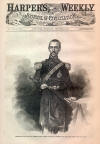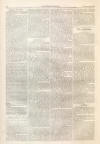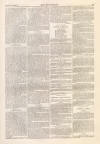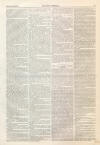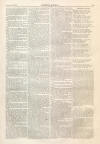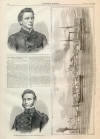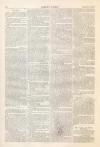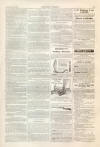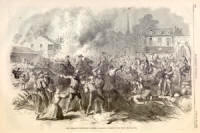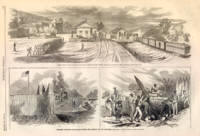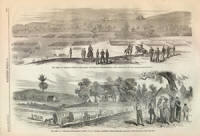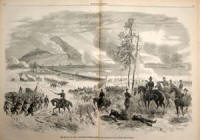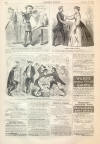Battle Cedar Mountain (Cont)
|
|
This Site:
|
AUGUST 30, 1862.] HARPER'S WEEKLY. 559 (Previous Page) Madison Court House was merely a feint to detain the army corps of General Siegel at Sperryville, and that the main attack of the enemy would be at Culpepper, to which place I had thrown forward part of Generals Banks's and McDowell's corps. Brigadier-General Bayard, with part of the rear of M'Dowell's corps, who was in the advance, near the Rapidan, fell slowly back, delaying and embarrassing the enemy's advance as far as possible, and capturing some of his men. The forces of Generals Banks and Siegel, and one of the divisions of General McDowell's corps, were rapidly concentrated at Culpepper during Friday and Friday night, Banks's corps being pushed forward five miles south of Culpepper, with Ricketts's division of McDowell's corps three miles in his rear. The corps of General Siegel, which had marched all night, was halted in Culpepper, to rest for a few hours. On Saturday the enemy advanced rapidly to Cedar Mountain, the sides of which they occupied in heavy force. General Banks was instructed to take up his position on the ground occupied by Crawford's brigade, of his command, which had been thrown out the day previous to observe the enemy's movements. He was directed not to advance beyond that point, and if attacked by the enemy to defend his position and send back timely notice. It was my desire to have time to give the corps of General Siegel all the rest possible after their forced march, and to bring forward all the forces at my disposal. The artillery of the enemy was opened early in the afternoon; but he made no advance until nearly five o'clock, at which time a few skirmishers were thrown forward on each side under cover of the heavy wood in which his force was concealed. The enemy pushed forward a strong force in the rear of his skirmishers, and General Banks advanced to the attack. The engagement did not fairly open until after six o'clock, but for an hour and a half was furious and unceasing. Throughout the cannonading, which at first was desultory, and directed mainly against the cavalry, I had continued to receive reports from General Banks that no attack was apprehended, and that no considerable infantry force of the enemy had come forward. Yet toward evening the increase in the artillery firing having satisfied me an engagement might be at hand, though the lateness of the hour rendered it unlikely, I ordered General McDowell to advance Ricketts's division to support General Banks, and directed General Siegel to bring his men upon the ground as soon as possible. I arrived personally on the field at seven P.M., and found the action raging furiously. The infantry firing was incessant and severe. I found General Banks holding the position he took up early in the morning. His losses were heavy. Ricketts's division was immediately pushed forward, and occupied the right of General Banks, the brigades of Crawford and Gordon being directed to change their position from the right and mass themselves in the centre. Before this change could be effected it was quite dark, though the artillery fire continued at short range without intermission. The artillery fire at night, by the Second and Fifth Maine batteries in Ricketts's division, of General McDowell's corps, was most destructive, as was readily observable the next morning in the dead men and horses and broken gun-carriages of the enemy's battery which had been advanced against it. Our troops rested on their arms during the night in line of battle, the heavy shelling being kept up on both sides until midnight. At daylight the next morning the enemy fell back two miles from our front, and still higher up the mountain. Our pickets at once advanced and occupied the ground. The fatigue of the troops, from long marches and excessive heat, made it impossible for either side to resume the action on Sunday. The men were, therefore, allowed to rest and recruit the whole day, our only active operation being of cavalry on the enemy's flank and rear. Monday was spent in burying the dead and in getting off the wounded. The slaughter was severe on both sides, most of the fighting being hand to hand. The dead bodies of both armies were found mingled together, in masses, over the whole ground of the conflict. The burying of the dead was not completed until dark on Monday, the heat being so terrible that severe work was not possible. On Monday night the enemy fled from the field, leaving many of his dead unburied and his wounded on the ground and along the road to Orange Court House, as will be seen from General Buford's dispatch. A cavalry and artillery force, under General Buford, was immediately thrown forward in pursuit, and followed the enemy to the Rapidan, over which he passed with his rear-guard by ten o'clock in the morning. The behavior of General Banks's corps during the action was very fine. No greater gallantry and daring could be exhibited by any troops. I can not spead too highly of the coolness and intrepidity of General Banks himself during the whole of the engagement. Ile was in front and exposed as much as any man in his command. His example was of the greatest benefit to his troops, and he merits and should receive the commendation of his Government. Generale Williams, Augur, Gordon, Crawford, Prince, Green, and Geary behaved with conspicuous gallantry. Augur and Geary were severely wounded, and Prince, by losing his way in the dark, while passing from one flank to another, fell into the hands of the enemy. I desire publicly to express my appreciation of the prompt and skillful manner in which Generals McDowell and Siegel brought forward their respective commands and established them on the field, and of their cheerful and hearty co-operation with me from beginning to end. Brigadier - General Roberts, Chief of Cavalry of this army, was with the advance of our forces on Friday and Saturday, and was conspicuous for his gallantry and for the valuable aid he rendered to Generals Banks and Crawford. Our loss was about fifteen hundred killed, wounded, and missing, of whom two hundred and ninety were taken prisoners. As might he expected from the character of the engagement, a very large proportion of these were killed. The enemy's loss in killed, wounded, and prisoners, we are now satisfied, is much in excess of our own. A full list of casualties will be transmitted as soon as possible, together with a detailed report, in which I shall endeavor to do justice to all. JOHN POPE, Major-General Commanding. The following account from a Herald correspondent, who was an eye-witness of the fight, will also be found interesting: EARLY IN THE MORNINGGeneral Pope had sent General Banks's command to the front, and the divisions of Generals Augur and Williams were placed in position about a mile and a half this side the ground which had been the scene of the skirmish of the previous day. SUBSEQUENTLY, IN THE AFTERNOON,Crawford's brigade, of General Williams's division, composed of the Forty-sixth Pennsylvania, Tenth Maine, Fifth Connecticut, and Twenty-eighth New York regiments, with Best's battery of Regulars, moved forward and occupied a piece of high ground lying between Cedar Creek and Crooked River, some four miles north of the point where the Culpepper and Gordonsville turnpike crosses the Rapidan River. About three fourths of a mile south of this point rises the Cedar Mountain, a spur of the great Thoroughfare Range. It was from the slope of this eminence that the enemy first opened their fire upon the Union troops. THE FIRST INTIMATION OF THE ENEMY.The first intimation our advance received of the presence of the enemy was at the moment when, after emerging from the timber on time north, it began to cross Spring Creek. At once it battery of heavy guns, posted in the thick timber half-way up the mountain side, belched upon the troops both shot and shell, while another battery of smaller guns at the foot of the mountain gave them a similar reception from the cover of some timber about three-eighths of a mile to the westward. OUR REPLY.Preparations were at once made to reply to these civilities, and Best's battery of Parrott guns was immediately planted on time crest of the rising ground we occupied, and began replying to the two batteries of the enemy. In the mean time the infantry were posted in line of battle on the right of the battery, and cheerfully awaited the order which would bring them more actively into the deadly conflict. THE PERSISTENT FIRING OF THE REBELS.For half an hour at least the enemy maintained a continuous fire from both their batteries, replied to in rapid succession by Captain Best's, when there opened simultaneously three other rebel batteries, posted in as many different localities, opposite our front and right. THE REBEL INFANTRY APPEAR.For some time this contest of shot and shell was kept up; but at five o'clock the rebel infantry were discovered in strong force upon our right and in front, supporting the rebel batteries. The fact was at once communicated by rapid couriers to the main body of our troops. Immediately the division of General Augur, with the remainder of General Williams's division, were thrown forward with prompt dispatch, and posted advantageously upon the right of General Crawford, and directly fronting the dense timber where the rebel infantry, in strong force, were plainly visible. GENERAL BANKS NOW RODE ON TO THE FIELDand directed the operations, the best possible disposition being made for the continuation of the fight now inevitable, and each moment developing in proportions. The manner in which he handled his troops and provided for every emergency, together with the personal gallantry he displayed, being constantly under fire, are subjects of general commendation with officers and men. GENERAL GEARY IN ADVANCE—BRAVERY OF THE COMMAND.General Geary's brigade, of General Augur's division, had the advance, which through the brunt of the first part of the day's fight it maintained with skill and courage. This gallant brigade consisted of the Fifth Ohio, Seventh Ohio, Twenty-ninth Ohio, Twenty-eighth Pennsylvania, and Snapp's battery. No sooner had these troops formed in order of battle than the rebels opened musketry fire upon them from two sides and in front, while time rebel batteries also directed their death-dealing missiles among the brave fellows, that on the mountain being very destructive in its effects. Notwithstanding this terrible concentrated fire, the troops, under their courageous General (Geary), never faltered or winced. THE BATTLE BECOMES GENERAL.It was not till half past five that the battle became general. Then artillery replied to artillery, musketry to musketry, while infantry met infantry in repeated shocks of deadly strife. Reckless valor and desperation marked the progress of the fight, which continued without pause or lull, with terrible cannonading, until darkness put a stop to the carnage. I have witnessed many battles during this war, but I have seen none where the tenacious obstinacy of the American character was as fully displayed. THE DETERMINATION OF OUR TROOPS.Our troops fought with the coolness and valor of veterans, standing up to the fight unfalteringly and unblenchingly in time teeth of a raking and destructive fire of cannon and musketry. No sooner did a volley of musketry or a discharge of artillery mow down the ranks of a regiment than the wide gaps were filled up and new fronts presented. OUR ARTILLERY PLAY WITH EFFECT.Once informed of the position of the enemy in force, our artillery opened with terrible effect upon them, compelling regiment after regiment to break and fall back out of range, within the shelter of the dense timber. DEATH OF THE REBEL GENERALS WINDER AND TRIMBLE.As regiments thus fell back fresh troops were in quick succession brought up to confront the deadly storm of iron hail from the Union guns, and it was while leading up some of these fresh regiments that Generals Winder and Trimble were killed. THE REBEL ARTILLERY—CHARGES AND CAPTURE OF REBEL GUNS.
The rebel artillery was served
with deadly effect, and at one time it was determined to take one battery that
gave the greatest annoyance by the bayonet. A portion of the District of
Columbia troops charged most gallantly one of these batteries, and succeeded in
taking two of the rebel guns, with but little loss to our brave men. Portions of
Augur's and Williams's divisions, including Crawford's and Gordon's brigades,
made three dashing bayonet charges upon the rebel artillery. Each time the brave
fellows were repulsed with loss, the enemy's overpowering infantry support being
too much for our troops to cope with; but uncowed and undauntedly they returned
to the charge
THE EIGHTH AND TWELFTH REGULARS,attached to General Banks's corps, commanded by Captain Pitcher, did excellent service. Captain Pitcher was wounded severely, though not dangerously, in the knee, by a musket-shot; but he nevertheless kept the field at the head of his men until the close of the conflict. THE INFANTRY CEASE FIRING.With the setting in of night the musketry firing ceased, but the artillery on the mountain kept up an intermittent firing until near midnight. At twilight our troops withdrew to a small copse of wood, about half a mile to the rear of their first position, where they were joined soon after by the corps of Generals McDowell and Siegel, who formed on their rear. It was then that the hungry and wearied troops of General Banks were relieved by portions of these fresh troops. The former fell back half a mile, where, in a pleasant clover field, they rested on their arms from the fatigues of the day. A BRILLIANT NIGHT.The night was unusually lustrous, a bright moon shedding its radiance all around, and causing all prominent objects to be as plainly distinguishable as in the day. In the west loomed up Thoroughfare Mountain, from whose peak flashed at intervals a rebel signal light, indicative of the presence of the enemy, and to us, at the time, an assurance that the conflict of the past day would be resumed on even a larger scale, and with casualties and losses proportionate to the increased numbers to be engaged. BATON ROUGE.WE publish on page 556 a view of BATON ROUGE, LOUISIANA, the capital of the State, front a sketch by our special artist, Mr. Theodore R. Davis. Baton Rouge is or was a town of some 4000 inhabitants, on the left bank of the Mississippi, some 140 miles from New Orleans. It was called Baton Rouge (Red Stick) front the fact that a Spanish family residing here were murdered by the Chickasaw Indians, and their heads stuck on poles, where they were subsequently found by the French. On 4th August the rebels, under Breckinridge and Lovell, made an attack upon our forces at Baton Rouge. The rebels lead 15,000 men; we about 4000, under General Williams, who was killed by a cannon-shot at the commencement of the fight. The fight lasted three hours, and the rebels were repulsed. A correspondent of the Herald says: General Williams, in command of our forces, was killed, a cannon-ball taking his head completely off. Our loss was about 250 in killed and wounded, including several field-officers wounded. The rebel loss is said to be greater than ours. We captured a number of prisoners, among them Captain Blount, an artillery officer, and a member of Breckinridge's staff. Blount has been brought to this city. The prisoners state that Breckinridge lost his right arm. Lovell was killed, and Captains Allen and Chain, of Baton Rouge, and a lieutenant were killed. It is reported that we lost two guns and captured three. The last report is that we have lost no guns. Our force is much smaller than the enemy's. ADVERTISEMENTS.CASEY'S INFANTRY TACTICS. INFANTRY TACTICS, for the INSTRUCTION, EXERCISE, and MANEUVERS of the SOLDIER, A COMPANY, LINE of SKIRMISHERS, BATTALION, BRIGADE, or CORPS D'ARMEE. By Brig.-Gen. SILAS CASEY, U. S. ARMY. In Three Volumes. $2.50. WAR DEPARTMENT, WASHINGTON, Aug. 11, 1862. The system of Infantry Tactics prepared by Brig.-Gen. Silas Casey, U.S.A., having been approved by the President, is adopted for the Instruction of the Infantry of the United States, whether Regulars, Volunteers, or Militia, with the following modifications, viz.: First; That portion which requires that two companies shall be permanently detached from the battalion as skirmishers, will be suspended. Second: In Title First, Article First, the following will be substituted for paragraph six, viz.: "A Regiment is composed of ten companies, which will be habitually posted from right to left in the following order: First, sixth, fourth, ninth, third, eighth, fifth, tenth, seventh, second, according to the rank of captains." Secretary of War. Sent free by mail on receipt of price. D. VAN NOSTRAND, Publisher, No. 192 Broadway, New York. BURNETT'S Cooking Extracts. BURNETT'S FLAVORING EXTRACTS meet with much favor. They are used and endorsed by the first hotels in the States and in Canadas. The proprietors have many certificates of their purity and quality from those best qualified to judge. Portable Printing Offices,For the use of the Army and Navy, Druggists, Merchants, and Business Men generally. Printing Office, No. 2, press prints 5x 8 inches, $25.00 " " 3, " " 7x10 " 40.00 " " 4, " " 12x18 " 60.00 Circular sent on application to ADAMS PRESS CO., 31 Park Row New York. Ballard's Patent Breech-Loading Rifle.This arm is entirely new, and is universally acknowledged to be the nearest to perfection of any Breech-Loading Rifle ever made. Length of barrel 24 inches, weight of Rifle 7 pounds. Size of Calibre adapted to Nos. 32, 38, and 44 copper water-proof Cartridges. Also, Prescott's Cartridge RevolversThe 8in., or Navy Size, carries a Ball weighing 38 to the lb., and the No. 32, or 4in. Revolver, a Ball 80 to the lb. By recent experiments made in the Army, these Revolvers were pronounced the best and most effective weapons in use. For particulars call or send for a Circular to MERWIN & BRAY, Sole Agents, No. 262 Broadway, N. Y. Also Agents for the Soldier's BULLET-PROOF VEST. DO YOU WANT LUXURIANT WHISKERS OR MUSTACHES?—My Onguent will force them to grow heavily in six weeks (upon the smoothest face) without stain or injury to the skin. Price $1—sent by mail, post free, to any address, on receipt of an order. R. G. GRAHAM, No. 109 Nassau Street, N. Y. AGENTS, Male and Female, get the most ready-selling article, "Bird Work Holder." Sample 25 cents by mail. ALLYN & PHELPS, 429 Broadway. SOMETHING NEW. Local and Traveling Agent, wanted to sell our 20 New Articles of positive merit. Large profits made. Samples 25 cent, each. Inclose stamp for circular. RICE & CO., 83 Nassau St., N. Y. "MUSTACHES AND WHISTLERS IN 42 DAYS."—Don't buy "Ouguents" at $1 a box, but send 20 cents (coin) for a new BOOK containing this GREAT SECRET and many other, never before published. EIGHTH edition. Mailed free for two dimes. 8 for $1. Address C. E. HUNTER & Co., Hinsdale, N. H. J. H. Winslow & Co.100,000Watches, Chains, Sets of Jewelry, Gold Pens, Bracelets, Lockets, Rings, Gent's Pins, Sleeve Buttons, Studs, &c., &c. Worth $ 500,000, To be sold for ONE DOLLAR each, without regard to value, and not to be paid for until you know what you are to get. Send for Circular containing full list and particulars. Send 25 cents for a Certificate. Certificates of all the various articles, stating what each one can have, are first put into envelopes, sealed up, and mixed; and when ordered, are taken out without regard to choice, and sent by mail, thus giving all a fair chance. On receipt of the Certificate you will see what you can have, and then it is at your option to send one dollar and take the article or not. In all transactions by mail, we shall charge for forwarding the Certificates, paying postage, and doing the business, 25 cents each, which must be enclosed when the certificate is sent for. Five Certificates will be sent for $1, eleven for $2, thirty for $5, sixty-five for $10, and one hundred for $15. AGENTS.—Those acting as Agents will be allowed ten cents on every certificate ordered by them, provided their remittance amounts to one dollar. Agents will collect 25 cents for every Certificate and remit 15 cents to us, either in cash or postage stamps. Great caution should be used by our correspondents in regard to giving their correct address, Town, County, and State. Address J. H. WINSLOW & CO., 208 Broadway, New York. N.B. We wish it distinctly understood that all articles of jewelry not giving perfect satisfaction can be returned and the money will be refunded. READER! — If you want employment, or want the best (Two-threaded) Sewing Machine ever manufactured, send to ISAAC HALE, JR. & CO., Newburyport, Mass., for a descriptive circular of terms, &c. They pay a liberal salary or allow commission, as the Agent may choose. Particulars sent free. W. SUMNER & CO., New York.
Nazareth Hall Boarding School for
Boys,
Nazareth, Northampton County, Penn. Easy of access from New York by Central Railroad of New Jersey to Easton, and thence seven miles by stage. Agents, Messrs. A. Bininger & Co., Nos. 92 and 94 Liberty Street New York. Rev. EDWARD IT. REICHEL, Principal. FRIENDS OF SOLDIERS! All Articles for Soldiers at Baltimore, Washington, Hilton Head, Newbern, and all places occupied by Union troops, should be sent, at half rates, by HARNDEN'S EXPRESS, No. 74 Broadway. Sutlers charged low rates. BEAUTY.—Hunt's Bloom of Roses, a charming and perlecdy natural color for the cheeks, or lips. Will not wash off, but remains durable for years. Can only be removed with vinegar, and warranted not to injure the skin. Used by the celebrated Court Beauties of Europe exclusively. Mailed free from observation for one dollar. HUNT & CO., Perfumers, 133 S. Seventh St., Philad. CATARRH!—Dr. Goodale's CATARRH REMEDY penetrates to the very seat of this terrible disease, and exterminates it, root and branch. Price $1.00. Send a stamp for a pamphlet. Depot 612 Broadway. PRINCE'S FOUNTAIN PEN.— One filling writes 8 to 10 hours. Sent by mail. Send stamp for circular. GEO. F. HAWKES, No. 64 Nassau St. N. Y. $75 A MONTH!—I WANT TO HIRE AGENTS in every County at $75 per month and expenses, to sell a new and cheap Sewing Machine. Address (with stamp). S. MADISON, Alfred, Maine.
HARPER'S
CONTENTS: IRON-CLAD VESSELS. ILLUSTRATIONS. — Launch of the Monitor. — Portrait of Ericsson.—The Atlantic Forge.—Forging a Bloom.—Forging the Plate.—Drilling Plates.—Bending the Turret Plates.—Setting up the Turret.—Bending the Plates.—Trucking Plates.—Line-of-Battle-Ship cut down.—Screwing up the Bolts.—The Ram. IN THE BUFFALO COUNTRY. ILLUSTRATIONS.—The Lieutenant in Costume.—The Prairie Ocean.—The first Buffalo.—Storm on the. Plains. —Fording the Arkansas.—Kit Carson.—A Prairie Scene. —Painted Trees.—Dead Buffaloes—Prairie Dog Village. —A Shot at the Comanches.—A Pleasant Night.—Fate of Bill Williams. A PARTIE CAREE. THE CARTE DE VISITE. BENJAMIN SILLIMAN. MISTRESS AND MAID. A HOUSEHOLD STORY. By Miss MULOCK. THE LANGUAGE AND POETRY OF SMOKE. ST. LUKE'S HOSPITAL. ORLEY FARM. By ANTHONY TROLLOPE. Illustrated By J. E. MILLAIS. CHAPTER LXV. Felix Graham returns to Noningsby. CHAPTER LXVI. Showing how Miss Furnival treated her Lovers. CHAPTER LXVII. Mr. Moulder backs his Opinion. CHAPTER LXVIII. The First Day of the Trial. ILLUSTRATIONS.—The Drawing-Room at Noningsby. —And how are they all at dear Noningsby? CARLYLE'S FREDERICK THE GREAT. THE ADVENTURES OF PHLIP. By W. M. THACKERAY. (Concluded.) CHAPTER XLI. In which we reach the last Stage but One of this Journey. CHAPTER XLII. The Realms of Bliss. ILLUSTRATIONS.—The Last Stage but One. —The Good Fairy. ROMOLA. By the Author of "ADAM BEDE." CHAPTER VI. Dawning Hopes. CHAPTER VII. A Learned Squabble. CHAPTER VIII. A Face in the Crowd. ILLUSTRATIONS.—A Street in Florence.—A Recognition. SEADRIFT. MONTHLY RECORD OF CURRENT EVENTS. EDITOR'S EASY CHAIR. EDITOR'S DRAWER. ILLUSTRATIONS.—Love and Politics.—House-Cleaning. —How Mrs. Millefleurs Cleaned House.—A Misunderstanding. FASHIONS FOR SEPTEMBER. ILLUSTRATIONS. — Carriage or Dinner Toilet.—Autumn Pardessus. TERMS. One Copy for one Year .......................$3.00 Two Copies for One Year .....................5.00
Three or more Copies for One Year
(each) ....................2.00
HARPER'S MAGAZINE and HARPER'S WEEKLY, together, one year, 4.00. Professors and Teachers are requested to examine the Catalogues of School and College Text Books at the end of this Magazine. HARPER & BROTHERS, PUBLISHERS, FRANKLIN SQUARE, NEW YORK. 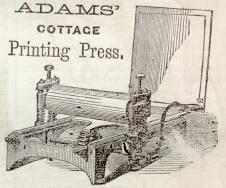 |
||||||||||||||||||||||||||||||
|
|
||
|
|
Site Copyright 2003-2018 Son of the South. For Questions or comments about this collection, contact paul@sonofthesouth.net |
|
|
Are you Scared and Confused? Read My Snake Story, a story of hope and encouragement, to help you face your fears. |
||
